Asking and Answering Questions About Soil Transcript
Teacher: Mari Rodriguez
Teacher [in interview]: Have you ever wondered what lives in soil? My second grade students at Amenier Primary Center are ready and eager to share. My name is Maricela Rodriguez. Come join us.
Students: I can ask and answer questions to understand.
Teacher [in interview]:I always begin by framing the lesson: what is the expectation? What is it we're going to learn?
Teacher [in class]: Today, we're going to be looking at soil. We're gonna be looking at two types of informational pieces to help...
Teacher [in interview]: In this lesson, we really go through the different modalities. They're talking about soil, they're listening what they have learned about soil. They're reading about soil. And they're writing about soil. So they're integrating the four modalities of learning.
+++ 00:01:00.15 +++
Teacher [in class]: First, to get us started about what soil is, I always want to know what you guys already know. I'm gonna ask you to please turn to your partner...
Teacher [in interview]: Once I share the objective, when I start a new topic, I do want to tap their prior knowledge.
Student: Soil is like...
Student: ...like dirt?
Student: Where the plants grow?
Teacher [in class]: I heard some really good things out there. You guys really know about soil so I'm looking forward to putting it up here on the circle map...
Teacher [in interview]: This is second grade, these are English language learners...this is a very good practice to use with English language learners because it is helping them to build academic language.
Teacher [in class]: Now, let me ask what is soil?
Student: Soil is dirt that feeds your plants because the dirt has some... vitamins for your plants to grow.
+++ 00:02:01.07 +++
Student: If you do not have soil, your plants will die and it wouldn't grow any more.
Student: Soil is dirt.
Teacher [in class]: Soil is dirt.
Student: Soil is where plants - where plants - are - and they are under the plants.
Teacher [in class]: Soil is under the plants. Now that we've shared some of the things that we know about soil, what I want you to do again is to turn to your partner and you're gonna ask your partner, "well, what questions do you have about soil?"
Students: What questions do you have about soil?
Teacher [in interview]: The reason that I ask them to do that is, of course because if we go back into what is our objective, our objective is to ask and answer questions about soil. But, what can be challenging about the Common Core is we have this pathway - we have the standards, but we don't have the how and the how is really up to the teachers. The students need to be practicing independently. And how does that look?
Student: How does soil help plants?
Student: Where does soil come from?
Student: What is soil made of?
Teacher [in interview]: One of the tasks they're gonna do is actually research - do research. So, one of these questions may end up being one of their research questions.
Student: Is soil brown?
+++ 00:03:14.09 +++
Student: Is soil dirty?
Teacher [in interview]: It's accountability in terms of helping them take ownership of their learning. These are their questions. These are not mine...
Teacher [in class]: They can just turn around that way and go that way. You can help me pass out these papers. What we're gonna do right now with this piece of informational text, boys and girls, is gather information about our question. Our question today is we will want to understand, what is soil? What I'm gonna do right now is I'm gonna give you a few moments to browse your informational sheet. Browsing means you're looking at your informational sheet - what does it have that you notice?
Student: I notice about this informational sheet that it has dark letters.
Teacher [in class]: Ooh! It has dark letters.
+++ 00:04:10.23 +++
Teacher [in class]: So, boys and girls, when we read informational text - informational text has what we call "text features." You remember when we talked about what text features are? And there's different types of text features and you just identified one. When you said dark, we call them bold face. That's a text feature. When we're reading informational text, it's important to pay attention to those text features because the information is organized and it helps us to comprehend.
Teacher [in interview]: One of the ways that I integrate academic language is talking about text features and how those features and informational text are really important in terms of helping us understand.
Teacher [in class]: The bold face, that's the dark. Who can tell me what's one of the bold face words on the informational sheet? Go ahead, Miguel.
Student: Soil layers.
Teacher [in class]: Yes. Soil layers. Yes, Matthew?
Student: I have a question about the soil layer picture. I wonder why it shows different layers. It shows one layer, two layers, three layers, four layers and I wonder why it has a tree on top.
+++ 00:05:22.11 +++
Teacher [in class]: Great! If we have time today to answer that as we dig into here and as we discuss this but, actually, Matthew, the picture that you are talking about - that has a special name. Can you see it from there? From here? No?
Student: Diagram.
Teacher [in class]: It's a diagram. Everybody say diagram.
Students: Diagram.
Teacher [in class]: Louder, please?
Students: Diagram!
Teacher [in class]: Thank you. The other feature is the headings and the sub-headings.
Teacher [in interview]: I had one of my students ask, "what's a heading?" And, that's great because, I'm thinking - because we've gone the text features before, I'm thinking, "they know that it's titles," but he was really good about asking, so I said, "oh, there's titles and there's smaller titles."
Teacher [in class]: Raise you’re hand and tell me what soil is made of. One or two things soil is made of. Go ahead, Christian - what's in soil?
+++ 00:06:11.14 +++
Student: It's made up of minerals.
Teacher [in class]: It has minerals! Did you guys know soil is made out of minerals. It's interesting. Brenda, say something else that it's made out of, please?
Student: It's made of dead plants.
Teacher [in class]: Did you guys know that plants are in soil? Really? Okay. Jose?
Teacher [in interview]: Another shift with the common core is that students need to be writing about what they're reading. And also they need to have independent practice of what they're practicing with the teachers. The next task will give an opportunity for the students to do that.
Teacher [in class]: You're gonna be reading and taking notes so do as much as the time allows you to...
Teacher [in interview]: One group of students is working independently at their desks and I'm working with a group of students on the rug, and we're working on the same task, except that I'm scaffolding the pages slower a- I'm right next to them so I can give them immediate support with any word that they don't understand or any concept they don't understand.
+++ 00:07:14.17 +++
Teacher [in class]: The first question is what does the soil have? So, if you look at the title - what color is the title in?
Student: Green.
Teacher: Green. What do you think - kind of information are you going to find in here? It says, "what is in soil?"
Students: Pebbles.
Teacher [in class]: Pebbles, that's right. Write everything that's in the soil.
Teacher [in interview]: Another shift with the Common Core is that we want our students to value evidence. These questions, one could say are text-dependent questions. When they - in terms of finding the answer, they have to go back into the text. That means that they have to go back and reread that sentence if they don't understand it the first time.
Teacher [in class]: So, then, what is silt?
Student: Minerals.
Teacher [in class]: And what else? Minerals and what?
Student: Soil?
Teacher [in class]: The silt. Read it again. Some of the tiny...
Student: Rocks.
Teacher [in class]: Rocks and...
Students: Minerals.
Teacher [in class]: So then what is silt?
Student: Rocks and minerals?
Teacher [in class]: There you go. Tiny rocks and tiny...
Student: Minerals.
Teacher [in class]: So let's write that. Ok, last question: "what are tiny pieces of dead plants and animals called? Let's come back to our book and say [with students], "plants and animals decay into tiny pieces called humus." So what are they called?
Student: Humans.
Teacher [in class]: Not humans, but humus, right?
+++ 00:08:46.02 +++
Teacher [in class]: I work with English language learners so I make sure that I'm repeating myself, that when I presented the informational sheet, I was using the overhead projector. I was underlining for them - I gave them a template so the question was written on the template for them and I walked around and I made sure that I pointed where the question was - there's different strategies that I used.
Teacher [in class]: We're gonna take a few moments. We're gonna take ten minutes and we're gonna write today what you learned about soil. What did...
Teacher [in interview]: In the end, I asked the kids to take our their journals and to spend some time writing about what they learned about soil. They're writing about what they learned so they get an opportunity to synthesize.
Student: Animals... animal... oh, here they are.
+++ 00:09:44.07 +++
Teacher [in interview]: One of the things that I read a while ago that made a big impression on me, said, "what is reviewed is remembered." So I really want to help them internalize the knowledge that they are learning and that is why I have them write and share. In closing the lesson, I always like to bring my kids to the rug and I always wanna give them an opportunity to communicate with each other what they've learned.
Student: I learned that worms live in soil. I also learned that silt is smaller than sand but bigger than clay.
Teacher [in interview]: Sharing with one another, they're communicating what they're learning. They are listening to one another and they're using the academic language. In a way it's validating what the knowledge that they're building. And in sharing with the whole group, that knowledge becomes part of the collective classroom knowledge.
[00:10:45.28]
Teacher [in class]: Let's look at our objective and let's see if we actually met our objective.
Teacher [in interview]: In the end, I like to come back to our objective. And say, did we meet this objective?
Teacher [in class]: Read it.
Students: I can ask and answer questions to understand the details about soil.
Teacher [in class]: Put your hands up if you think we met the objective. I'm gonna give you two thumbs up, boys and girls. I'm gonna give you a round of applause.

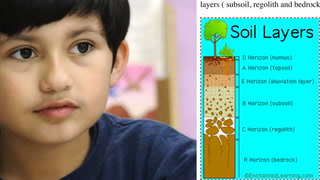
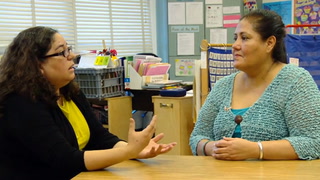

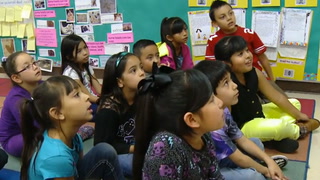
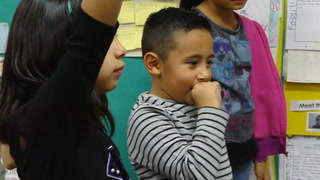
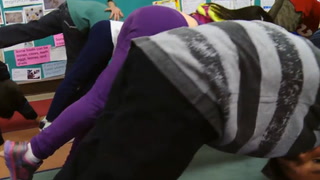








27 Comments
Jessi Knutson Sep 27, 2022 11:00am
1 . Ms. Rodriquez uses a variety of strategies to help her students retain the knowledge including circle maps, writing on paper, projecting and underlining key details or words. She gave the students time to write their own ideas and what they learned and then time to share that with their peers.
2. She supports her multi-lingual students by teaching vocabulary and allowing students to learn words she underlines and focuses on for them.
3. On the rug, Ms. Rodriguez allows students to share and is always welcoming and open to all questions and comments.
Doreen McRaven Jun 22, 2022 2:11am
Mary Linda Brewer Jun 21, 2022 2:13pm
The lesson was great. The children were engaged and eager to lean. The teacher gave children time to talk, question, and complete activity.
Kiersten Arnold Apr 27, 2018 1:26am